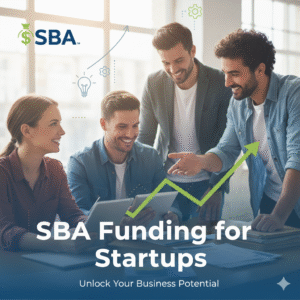SBA loans are like a beacon of hope for startups. They are government-backed business funding programs designed to help small businesses access capital for different needs, from launching and growing to recovering from setbacks.
To figure out which option is right for your startup, let’s understand the main types of SBA loans available.
Different kinds of SBA funding
- SBA 7(a) Loans: The most popular option, offering flexible funding for working capital, equipment, or expansion.
- SBA CDC/504 Loans: Ideal for purchasing fixed assets, such as real estate or major equipment.
- SBA Microloans: Smaller loans (up to $50,000) are ideal for startups and small businesses needing limited capital.
- SBA Disaster Loans: For businesses recovering from declared disasters.
- SBA Community Advantage loan
In this post, we’ll break down the different types of SBA funding and what you need to qualify for a fast business loan. We’ll also compare SBA loans with other popular funding options like venture capital, bootstrapping, and angel investors to help you figure out which path is best to finance your startup.
What Startups Get from SBA Funding
- Easier Access to Capital
The SBA guarantees a portion of your loan through partner banks. With the SBA as a safety net, lenders are less hesitant, allowing startups to qualify for funding that might otherwise be denied.
- Favorable Loan Terms
One of the key advantages of SBA loans is their extended repayment periods and relatively low interest rates. This provides startups with a secure financial environment, allowing them to focus on scaling without the constant pressure of high repayments.
- Support for Innovation
Startups with innovative ideas, particularly in fields such as biotechnology, can find encouragement in SBA programs like SBIR and STTR. These programs, which go beyond loans to offer research and development funding, can be a significant boost for startups.
- No Equity Dilution
Unlike investor funding, SBA loans don’t require giving up ownership. You receive the capital you need while still retaining control over your company.
Miriam Kattumuri built her business, Miriam’s Earthen Cookware, from the ground up in her backyard. After being diagnosed with gestational diabetes, she researched healthier cooking alternatives and discovered that clay pots retain more nutritional value in food. Inspired by this, Miriam traveled to India to learn traditional pottery-making and returned home to craft cookware from scratch.
Initially, Miriam bootstrapped her venture, operating out of a small backyard workshop. But as demand for her unique cookware grew, it became clear that she needed more space and better equipment to scale. In 2015, she secured an SBA Microloan, which allowed her to expand her workspace and upgrade her equipment. The loan was a turning point, enabling her to move beyond the constraints of her small workshop. With more space, she was able to organize her production process more efficiently, improving workflow and increasing her capacity to meet growing demand.
The upgrade in equipment also allowed Miriam to enhance the quality and consistency of her cookware. With better tools and machinery, she could craft more precise, durable, and beautifully finished products, which was essential to maintaining the high standards her customers expected. This improvement in production not only boosted the quality of her products but also helped her meet the increasing demand that had once been difficult to keep up with.
As her production increased, Miriam realized that she needed more hands on deck. The loan allowed her to hire additional employees to assist in manufacturing, quality control, and logistics, creating jobs and contributing to the local economy. With the expanded team, Miriam was able to streamline operations, cutting down on manual processes and focusing more on innovation and product development.
In 2021, Miriam secured a second SBA Microloan to further scale her business. This loan allowed her to expand her manufacturing team even further, ensuring that she could continue to meet the increasing demand for her products. The loan application process was swift, taking just 10 days, thanks to the support of Dorchester Bay Economic Development Corporation, who helped guide her through every step.
Today, Miriam’s Earthen Cookware is thriving. The business has expanded its reach globally, offering cooking workshops via Zoom and continuing to grow its product line. Miriam’s success story showcases how SBA funding can provide small businesses with the resources they need not only to start but to scale, innovate, and succeed in a competitive market.
Who should obtain SBA startup funding
SBA startup funding is designed to help small businesses, including startups, gain access to the capital they need to grow and succeed. Here’s a breakdown of who should consider obtaining SBA startup funding:
- New Entrepreneurs: Individuals with a solid business idea and plan but lacking sufficient capital to get their business off the ground. SBA loans are ideal for those who may not qualify for traditional bank loans due to limited financial history or assets.
- Small Business Owners: Anyone running a small business that meets the SBA’s criteria for size and industry. This includes businesses in various sectors like retail, manufacturing, services, tech, and healthcare.
- Veteran Entrepreneurs: Veterans who are looking to start or expand their businesses can benefit from specialized SBA programs like the Veterans Advantage. These loans offer reduced fees and more favorable terms for veterans.
- Minority-Owned Businesses: Entrepreneurs from minority groups may qualify for additional support through programs that aim to increase access to capital for underserved communities. The SBA provides resources and funding opportunities specifically designed for minority-owned businesses.
- Women Entrepreneurs: Women who are looking to start or grow their business can access funding through initiatives like the Women’s Business Center (WBC) program, which helps women entrepreneurs with resources and funding options.
- Businesses in Need of Expansion: Startups that are already operational but need capital to scale, hire staff, purchase equipment, or expand operations. SBA loans can provide flexible funding for businesses looking to grow or increase production capacity.
- Businesses with a Clear Plan: Entrepreneurs who have a strong business plan, a clear vision for growth, and the ability to repay the loan. SBA lenders typically require a detailed business plan that outlines how the funds will be used and the expected return on investment.
- Socially and Economically Disadvantaged Entrepreneurs: The 8(a) Business Development Program helps businesses owned by individuals who are economically or socially disadvantaged, offering financial assistance and government contracting opportunities.
- Eco-Friendly and Green Businesses: Startups focused on sustainability or renewable energy might also qualify for SBA funding, as there are specific programs aimed at supporting green businesses and those that promote environmental sustainability.
- Tech Startups: Startups in the technology space can also benefit from SBA funding, particularly those that are in the early stages of product development or looking to scale their operations
But they are most suited for entrepreneurs who
- Run a new or early-stage small business and need a capital or grant for equipment, inventory, real estate, or working capital.
- Have a business in areas affected by disaster to recover from damages.
- It can be challenging to qualify for traditional bank loans due to a low credit history, lack of collateral, or low annual revenue.
- Own a legally registered U.S. business with a solid business plan.
- Have good creditworthiness and are willing to make a reasonable personal investment.
- Bring industry experience and can demonstrate the ability to repay within the given time.
Requirements for SBA
The chances of a startup securing a loan directly from a traditional financial institution are slim to none. That’s because startup loans are considered high-risk; new companies often lack a strong credit score, tangible collateral, or a predictable annual revenue.
Banks and other large financial institutions prefer lending to businesses with an established track record. Years of consistent operations translate into higher credit scores and financial reliability, which is often lacking in the early stages of startups.
Different SBA lenders have specific requirements, so it’s essential to know the exact type of loan you’re applying for and prepare the proper documents to match. Here are some of the most common requirements
- Strong business plan.
- Good credit history (personal & business).
- Some collateral in most cases.
- Demonstrated ability to repay.
Understanding the various types of small business loans is a crucial step in selecting the most suitable one for your business objectives. For example, the SBA offers several loan programs that cater to startups, including microloans and Community Advantage loans, which are specifically designed for newer businesses, particularly in underserved communities.
SBA 7(a) Loans
The SBA 7(a) loan program is the most widely used SBA loan program. It comprises seven loan types that provide businesses with access to funding for a broad range of needs, including working capital, equipment purchases, inventory purchases, debt refinancing, and even business acquisitions. The SBA guarantees 85% of the loan, reducing lender risk, and funds can be used for up to $5 million. Repayment and interest terms vary based on the lender and purpose, typically ranging from 1 to 10 years for working capital and 10 to 25 years for real estate.
While SBA 7(a) loans are often praised for their flexibility, they remain one of the toughest options for startups to access. Lenders still shoulder part of the risk despite the SBA guarantee, so they tend to favor applicants with an operating history, proven revenue, or available collateral. Startups, on the other hand, usually lack these markers and rely heavily on projections, which most SBA lenders view as uncertain. Since repayment must ultimately come from business cash flow, the absence of a profit track record makes approval difficult, even when the business plan is strong.
SBA CDC/504 Loans
These are smaller loans, capped at $50,000, designed to help startups and small businesses that need limited funding. Microloans can be used for things like working capital, inventory, supplies, and equipment, but not for paying existing debts or purchasing real estate. They are disbursed through nonprofit community-based lenders and are often coupled with business training or mentorship.
SBA Microloans
These are smaller loans, capped at $50,000, designed to help startups and small businesses that need limited funding. Microloans can be used for things like working capital, inventory, supplies, and equipment, but not for paying existing debts or purchasing real estate. They are disbursed through nonprofit community-based lenders and are often coupled with business training or mentorship.
SBA Disaster Loans
These loans provide financial assistance to businesses affected by declared disasters (natural disasters, civil unrest, or even economic crises like COVID-19). They can be used to repair or replace real estate, machinery, equipment, and other assets that were damaged. Terms are generally long (up to 30 years), with low interest rates to ease recovery.
SBA Community Advantage loan
Startups with limited access to resources aren’t left out. The Community Advantage Loan is a pilot program designed specifically for underserved/minority-owned businesses that may not qualify for traditional SBA loans. It supports local startups and companies in low- to moderate-income areas, helping them access the capital they need to grow.
These loans can be as high as $350,000 and are distributed through community development organizations rather than traditional banks, making them more accessible to entrepreneurs who need them most.
How to apply for SBA funding for startups
- Check eligibility: Ensure your startup meets the criteria set by the SBA.
- Prepare your business plan & financial projections: ensure all your paperwork is up to date.
- Choose a loan type: Confirm your documentation matches your loan type
- Apply through an SBA-approved lender: Use the lender match tool to find SBA lenders with extensive experience and expertise.
- Wait to get SBA guarantee approval.
Tips for fast approval
- Have all necessary documents ready (business plan, financial statements, tax returns, and collateral information).
- Keep your debt-to-income ratio low—lenders check how much you owe versus what you earn.
- Build a relationship with the lender before applying.
How to get an SBA loan for a startup with no history of profit
Startups often have no operating history, but SBA loans can still work if you:
- Use your personal credit score; it’s the primary indicator of trust for lenders.
- Provide detailed financial projections backed by market research (show lenders how revenue will come in).
- Show personal investments, e.g., cash and assets you have put into the business
Alternatively, consider an SBA Microloan—they’re designed for very young companies and have looser requirements.
SBA Loans vs Venture Capital vs Bootstrapping vs Angel Investor.
When it comes to funding a startup, founders usually consider a few main options, each with its own unique benefits and challenges.
That’s why it’s essential to clearly define your business goals and understand the risks before choosing a path.
In the table below, we’ll compare the most common funding models to help you decide which might be the best fit for your business.
| Funding Type | Ownership | Eligibility | Risk | Funding amount | Best for |
| SBA Loan | Full Ownership | Small business, good credit score, etc. | Must repay | Depends on the SBA loan type | Revenue-generating businesses/startup |
| Bootstrapping | Full Ownership | Self-funded | Slow scale | Founder’s capacity | Founders who want control/choose lean |
| Venture Capital | Board Control | High growth potential | Pressure/loss of ownership | Very high (billions) | Tech/startups with fast market dominance |
| Angel investor | Give up small equity | Early stage/strong pitch | Less pressure/equity loss | Moderate | Startups that need seed money/ Scale |
FAQ
Q: How long does it take to get an SBA loan
Ans: SBA loans take 30–90 days to process because of the paperwork, credit checks, and SBA guarantee approval. However, some lenders in the SBA’s Preferred Lender Program can make decisions faster—sometimes within 2–3 weeks.
Q: How do I qualify for it
Ans: A registered U.S.-based business that meets SBA size standards.
A solid business plan and financial projections.
A good credit score (usually 650+).
Q: Do I pay back the SBA loan
Ans: Yes. An SBA loan is not a grant; therefore, it must be repaid with interest.
Final Thoughts
SBA funding stands apart from venture capital or bootstrapping because it’s government-backed debt financing, not equity. This means startups can access growth business capital without giving up ownership or control of their business.
While the process may seem rigorous, the long-term benefits, favorable terms, lower interest rates, and structured repayment plans make it worthwhile to consider.
Too often, founders overlook SBA programs, assuming they are out of reach or too complex to understand. In reality, with proper preparation and an understanding of the available options, SBA loans can be a powerful tool for building a sustainable startup.








